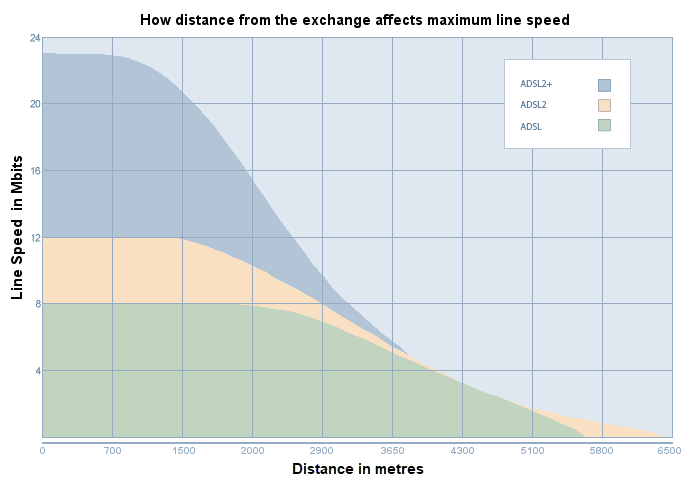Why does ADSL broadband speed depend on the distance from the exchange?
Unlike cable, broadband connections using ADSL broadband technology is distance-sensitive: the further you are from the exchange the slower the connection. This is because the data is transmitted over copper wires (the same wires that are used for your phone calls) and the strength and quality of the signal transmitted along the copper wires degrades with distance. This is commonly referred to as 'noise' and is explained at the end of this article.
You will be familiar with this noise when you hear crackling and noises on the line when making phone calls. Even with noise on the line that causes you to miss some of the words you can still understand the conversation. Unfortunately, digital communication does not tolerate missing data and any missing information has to be re-sent and these delays reduce your download speed.
There are devices that improve broadband signal quality and reduce noise - such as the micro-filters that many consumers have fitted in their homes. The most common one is BT iPlate which has been developed by BT and it has been proven by many consumers to speed up your ADSL connection. Please read our article "How to improve broadband speed" for information on how to get the best speed from your Internet connection.
How Does Speed Vary with Distance?

The graph above shows how distance from the exchange affects line speed for ADSL (max 8 Mb/s), ADSL2 (12 Mb/s) and the latest ADSL2+ (24Mb/s). Essentially, the standard ADSL can work up to 5.5km from the exchange. However, to get 8Mbit you would need to be located no further than 2km from the exchange. Similarly, ADSL2 can work up to 6km but you need to be no further than 1.5km to get 12Mb/s. ADSL2+ offers the best line speed (24Mb/s) up to 1Km from the exchange.
| Top Speed | Optimal Distance | Maximum Distance | |
|---|---|---|---|
| ADSL | 8 Mb/s | < 2 Km | 5.5 Km |
| ADSL2 | 12 Mb/s | < 1.5 Km | 6 Km |
| ADSL2+ | 24 Mb/s | < 1 Km | 6 Km |
Why is There Noise on the Line?
To understand why noise exists we need to look at how traditional telephones work. Copper wires are used to transmit voice calls using the frequencies up to 3400 Hertz. However, the frequency potential of these wires is much higher and this led to the discovery of ADSL technology (Asymmetric Digital Subscriber Line). ASDL takes advantage of the higher frequencies on the copper wire which are not used by voice. More of these frequencies are used for downloading data than for uploading - that's why it is called 'Asymmetric' DSL. This decision was made because most users receive more data than they send.
Any signal that is carried through the wires is affected by Resistance, Capacitance and Inductance. These characteristics of the copper wire directly contribute to the noise on the line and their effect is greater the longer the line.

